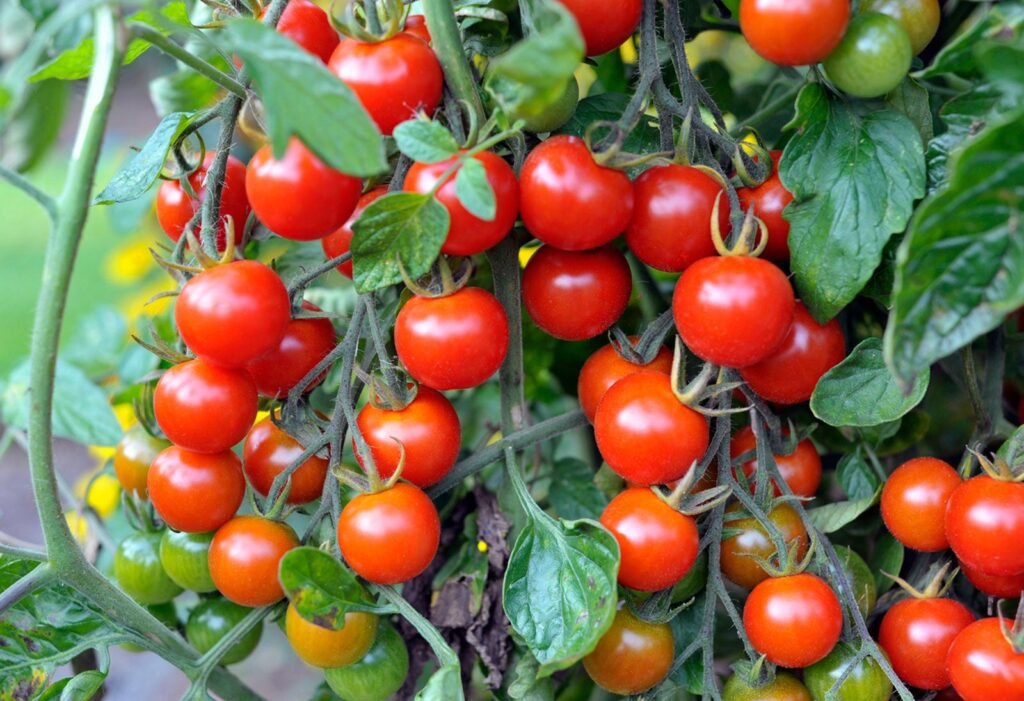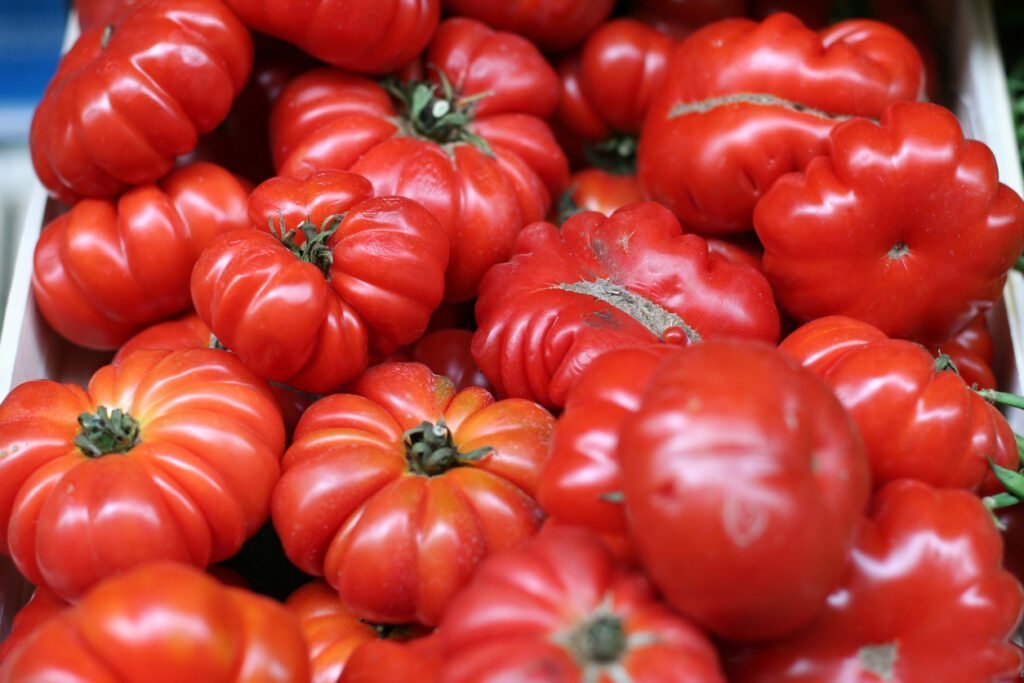Tomatoes, the jewel of summer gardening there is a doubt for the enthusiastic gardener that the appeal of a completely ripe tomato is rejected but there is also the risk of stem breakage or insect attack. This is of paramount importance in the field of tomato production. In this comprehensive guide, we delve into the art of tomato harvesting, exploring two strategic approaches: plucking when fully ripe or opting for semi-ripeness with subsequent indoor maturation.

The Two Harvesting Strategies Unveiled
when a tomato gets older, their color changes the sweetness increases and the feeling also becomes different. People usually harvest tomatoes when they are fully grown, but there are some benefits of breaking early. Picking them early can prevent bugs, splits, and uneven ripening, let’s compare two methods of harvesting tomatoes and learn how to ripen them from the inside.
Harvesting Fully Ripe Tomatoes: A Tempting Summer Indulgence
A warm and ripe tomatoes is very tasty in summer, and gardeners want it, but this is not easy to choose when to take them. A smart tomato person, Craig Le Houllier, tells you to have a plan, because ripe tomatoes on the plant are not good for long. You need to eat or cook them fast, or they will spoil. That is why they are good for a nice tomato sandwich.
Cues for Full Ripeness:
- Days to Maturity: Learn how much time your tomato kind needs to go from planting to picking. Some kinds are quick and finish in 55 days or less, but some kinds are slow and take 85 days or more.
- Fruit Color: A very ripe tomato should look like the color on the seed bag. Red tomatoes are easy to see, but you need to know more to tell if other colors are ripe.
- Feel: Touch the tomato softly; a ripe one should feel a little soft. It should not be too hard or too soft.
- Fragrance: Ripe tomatoes smell different. You can smell them to check if they are ripe.
- Ease of Picking: A very ripe tomato should come off the plant easily when you pull it lightly. Be careful not to hurt the plant or bother the other tomatoes that are not ripe yet.
Harvesting Partially Ripe Tomatoes: A Strategic Maneuver
Lehoullier is smart about under ripe tomatoes. He says you should pick them when the tomatoes have most of their color, but some of it is green so the tomatoes will not burst or break down and it is a good alternative to the normal method.
Stages of Ripeness:
Understanding the stages of tomato ripening provides a strategic advantage. From the green stage to full ripeness, each phase offers distinct benefits:
- Green Stage: The fruit is entirely green, lacking mature color. Picking at this stage compromises flavor and color development.
- Breaker Stage: The green color begins to transition, with up to 10% of the fruit showing hints of mature color. Suitable for indoor ripening.
- Turning Stage: Between 10% and 30% of the fruit exhibits color.
- Pink Stage: 30% to 60% of the fruit has colored.
- Light Red Stage: At 60% to 90% color development, ideal for large-fruited heirlooms.
- Red or Fully Ripe: Beyond 90% coloration indicates full ripeness. Read more
Different kinds of tomatoes
Tomatoes are not all the same. They have different sizes, shapes, colors, and tastes. Some kinds of tomatoes that people enjoy are:
- Cherry tomatoes: cherry tomatoes are small and good. you can also put them in salad, eat them by themselves, or cook them. They are many different colors like red, yellow, orange, green or black. Some types of cherry tomatoes are Sungold, sweet 100 and black cherry.

- Grape tomatoes: grape tomatoes are like cherry tomatoes, but they are shaped like egg and not soft. They don’t spoil or get crack quickly. You can put them also in salad, have them alone, or cook them. Some names of grape tomatoes are Juliet, Apero, and Chocolate Sprinkles.

- Plum tomatoes: These are also called paste or sauce tomatoes,because they have meaty texture and less water content.they are ideal for making sauces ,soups or salsa.They are usually red, but they can also be yellow or green. Some examples of plum tomatoes are San Marzano, Amish Paste, and Green Zebra.

- Beefsteak tomatoes: These are the largest and juiciest tomatoes with a rich and complex flavor thta are perfect for sandwitches or stuffing . They are usually red, but they can also be pink, yellow, orange, or striped. Some examples of beefsteak tomatoes are Brandywine, Big Beef, and Pineapple

- Salad tomatoes: These are medium sized tomatoes that are great for cutting salad or cooking. have a balanced taste and texture and come in a variety of colors and sizes. Some examples of salad tomatoes are Early Girl, Better Boy, and Lemon Boy.

check out Black Strawberry Tomatoes
Navigating the Impact of Weather
whether, that can change rapidly, affects how you pick your tomatoes. Sometimes rain and sun can help or hurt tomatoes.
Rainstorms and Tomato Integrity
Sometimes after rain, you see small tomatoes with cracks and big tomatoes with splits. This is sad and happens when it rains a lot after a dry time. Green tomatoes can get hurt, but red or almost red tomatoes are worse. They go bad quickly and bugs come to eat them. Picking them before a lot of rain or water is a smart thing to do.
The Autumnal Challenge
Be careful around the end of the growing season. When it’s cold. Tomatoes do not grow fast in cold, and frost can damage plants and fruits. Picking green tomatoes when the weather is not ripe gives you more tomatoes. You can make chow chow with green tomatoes or fried green tomatoes.
Unveiling the Risks: Pests and Pitfalls
Very ripe tomatoes can cause problems to the plant as some animals may try to eat them. Too much water can make them break down and bring in more animals. You need to know when to take them out.
The Expert’s Choice: Strategic Harvesting
craig le Houllier demonstrates his method of picking tomatoes when they are mostly ripe but not completely ripe. This helps avoid cracks and animals .it allows them to ripen inside for a day or two
check out Identifying Plant Pests and Diseases
Harvesting Unripe Tomatoes: A Tactical Approach
There’s more that can be done with unripe tomatoes. Lehoullier says you don’t have to wait for all of them to turn red; you can ripen tomatoes on the plant or after picking them.
The Six Stages of Ripening smart gardener plan better.
Knowing how tomatoes change as they ripen helps the smart gardener plan better from green to red, each step has different features, letting you choose when to pick them for best taste and health.
The Art of Indoor Ripening
How you ripen tomatoes inside is important. Where you keep them and what you do can change how they turn out. Here are some tips to ripen tomatoes well inside:
- Bright Location: Choose a well-lit spot away from direct sunlight to avoid toughening the skins.
- Temperature Considerations: Average room temperature or slightly cooler settings suffice; steer clear of refrigeration to preserve flavor and texture.
- Ethylene Gas and the Paper Bag Technique: Capitalize on the ethylene gas emitted by ripening tomatoes by placing them in a paper bag. For an ethylene boost, consider adding a banana, albeit at the risk of imparting a banana-like taste to your tomatoes.
Check out How to be growing jalapenos in pots
Tailoring Harvest Strategies to Tomato Varieties
Not all tomatoes are created equal, and each variety demands a nuanced approach to harvesting.
Heirloom Tomatoes: A Patient Harvest
Heirloom tomatoes are special because they have different tastes and kinds like Brandywine Pink or Black Krim. Picking these big tomatoes needs some waiting. They are best when they are mostly ripe, but not all the way. This stops them from getting too ripe and going bad.
Cherry Tomatoes: A Daily Harvest Ritual
Cherry tomatoes are sweet and make a lot of fruit in the garden. You have to check them every day, because they get ripe fast. Picking them is best when each tomato is the right color, so they don’t break in rainy weather.
Harvesting Frequency and Techniques
To stop tomatoes from breaking or splitting, you have to watch them carefully. You have to pick the ripe ones quickly and often. How often and how you do it depends on the kind of tomato.
Frequency of Harvest:
- Cherry Tomatoes: Daily checks as soon as the first fruits ripen.
- Large-Fruited, Saladette, and Plum Tomatoes: Inspect every few days to maintain optimal quality.
Picking Techniques:
A way to pick tomatoes without hurting them is to use garden snips or pruning shears. These are the best tools to use. Other ways can make the tomatoes squish or bruise. These tools can stop that from happening.
check out Optimizing Your Garden for Potato Bug Control
A Final Word on Tomato Mastery
To grow and eat tomatoes, you need to know how they ripen, how does the weather affect them and how to prevent bugs. Use the tips in this guide when you are picking your tomatoes.
In conclusion, the mastery of tomato harvesting is a subtle dance with nature, an artistry that transforms the gardener into a symphony conductor, orchestrating the perfect notes for each harvest. May your tomatoes be bountiful, your harvests impeccable, and your culinary adventures infused with the essence of a summer garden.
Pingback: When to Harvest Jalapenos: A Comprehensive Guide -
Pingback: Benefits of Companion Planting: A Guide for Gardeners
Pingback: Cucumber Types List with Pictures & Tips -
Pingback: How to Grow Raspberries at Home: A Complete Beginner’s Guide
Pingback: Peppers: The Ultimate Guide to Growing From Seed to Plate -
Pingback: Okra Plant: How to Grow, Care For, and Harvest – Quick Guide
Pingback: Grow Your Own Wisteria from Seeds: A Step-by-Step Guide -
Pingback: Growing Beans: A Complete Guide to Homegrown Goodness in Your Garden
Pingback: Potato Growth Stages: How to Plant, Grow and Harvest -
Pingback: Growing a Fruitful Mango Tree: A Global Perspective -
Pingback: Everything You Need to Know to Grow Monstera Deliciosa fruit
Pingback: How to Prune Tomato Plants - Gardener's School
Pingback: Carrot Goodness: A Step-by-Step Guide to Growing Own at Home
Pingback: From Patio to Plate: The Best Vegetables to Grow in ...